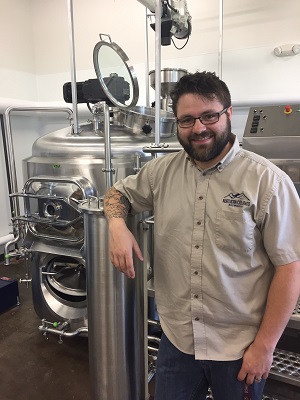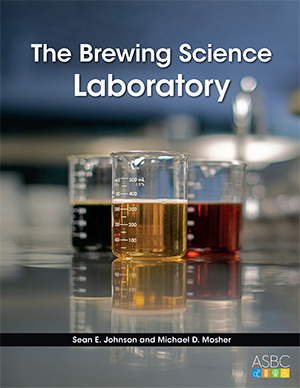, which provides practical advice for establishing a laboratory and a QA program alongside a solid foundation of scientific information. We talked to the authors about their backgrounds and their reasons for writing this book.
 A: SEAN JOHNSON – Back in the fall
of 2010, when I first began my undergraduate chemistry degree, I was clueless
as to what area of the workforce I wanted to join. That all changed in the fall
of 2013, when I took coursework in brewing laboratory science. During these
classes, I discovered the vast world of brewing and how many career
opportunities there were in areas of the industry beyond the typical brewery
positions as a brewer, cellar man, and packaging specialist. I began
homebrewing and researching the brewing industry. Once I started my master’s
program in chemistry in the fall of 2014, I knew there was nothing more I
wanted to study and ultimately pursue as a career than brewing laboratory
science.
A: SEAN JOHNSON – Back in the fall
of 2010, when I first began my undergraduate chemistry degree, I was clueless
as to what area of the workforce I wanted to join. That all changed in the fall
of 2013, when I took coursework in brewing laboratory science. During these
classes, I discovered the vast world of brewing and how many career
opportunities there were in areas of the industry beyond the typical brewery
positions as a brewer, cellar man, and packaging specialist. I began
homebrewing and researching the brewing industry. Once I started my master’s
program in chemistry in the fall of 2014, I knew there was nothing more I
wanted to study and ultimately pursue as a career than brewing laboratory
science.
After graduation, I got a job in the malt
research laboratory at a major brewery, but I realized I missed interacting
with others as a peer and an instructor. During this time, I made sure to
continue to be involved as much as possible with the brewing laboratory science
program as the University of Northern Colorado (UNC). As the program continued
to grow, an opportunity opened up and I returned to my teaching career. As I continued
to work in education, I realized there were a ton of texts on various topics of
brewing, but none of them really helped the homebrewer who had never actually
been in a lab. I have many friends who homebrew that use poor techniques simply
because they don’t have the resources available to do tests properly. If I had
a dollar for the number of times that I’ve had to tell someone why a beaker
isn’t a great tool for making accurate volume measurements, I’d have quite a
few extra dollars!
 A: MICHAEL MOSHER – My first
exposure to craft beer was in the mid-1980s, when I was an undergraduate student.
I helped out in my spare time at the local brewpub as a brewer’s assistant. I
basically taught myself how to brew beer while I finished my undergraduate and
graduate degrees in organic chemistry. In the early 2000s, while I was working
as a professor in Nebraska, I started a course in brewing science as a way to
teach science to students who claimed not to like science. In 2012, I started
the brewing laboratory science program here at UNC, again in response to the
growing craft brewing industry. To make sure the information we were teaching
our students was applicable, I obtained a Diploma in Brewing qualification from
the Institute of Brewing and Distilling (UK) and am currently about halfway
through my studies to obtain the Master Brewer qualification.
A: MICHAEL MOSHER – My first
exposure to craft beer was in the mid-1980s, when I was an undergraduate student.
I helped out in my spare time at the local brewpub as a brewer’s assistant. I
basically taught myself how to brew beer while I finished my undergraduate and
graduate degrees in organic chemistry. In the early 2000s, while I was working
as a professor in Nebraska, I started a course in brewing science as a way to
teach science to students who claimed not to like science. In 2012, I started
the brewing laboratory science program here at UNC, again in response to the
growing craft brewing industry. To make sure the information we were teaching
our students was applicable, I obtained a Diploma in Brewing qualification from
the Institute of Brewing and Distilling (UK) and am currently about halfway
through my studies to obtain the Master Brewer qualification.
Students start our program with a detailed
introductory course and then take specific courses in laboratory analysis and
even work in the on-campus brewery. Unfortunately, there were no textbooks that
addressed the laboratory topics at the level needed. After recognizing the need
for learning materials that filled that niche but also could help small brewers
and homebrewers master basic laboratory techniques and principles, writing the
text The Brewing Science Laboratory was an obvious solution. Having
already published an introductory text on
brewing science, creating the lab text was easy.
Q.
Why is this book needed? Are there other
brewing science textbooks?
A: JOHNSON AND MOSHER – There are a
lot of textbooks that discuss the science behind brewing, admittedly in more
detail than our text does. However, few if any texts specifically relate how to
set up a laboratory, explain some basic theories of analyses, and teach how to
do those analyses. We found that many people either had a degree in analytical
chemistry or plodded through chemistry textbooks in hopes of finding the
information they needed. Our goal was to write a text that focused on exactly
what brewers needed to know.

Q.
What makes The Brewing Science Laboratory unique?
A: JOHNSON AND MOSHER – Many
different aspects of this text make it unique:
·
It emphasizes the theories, techniques, and
principles of the brewing laboratory. The text isn’t a rehash of the science
behind beer and brewing. There are already a lot of well-received texts on those
topics.
·
The text is written in a conversational style
that’s easy to read. Any book that takes this approach draws the reader in and
helps make each topic easier to understand and learn.
·
The text provides worksheets and rewritten
procedures that provide the novice with the tools needed to perform some basic
laboratory analyses. These procedures are adapted from the ASBC Methods of
Analysis, which represent the standard in the analysis of beer.
·
The book lays flat when opened. Thus, it’s
designed to be used in the laboratory as both a textbook with theories and
principles and also as a working manual for the lab.
Q.
Who will benefit from reading The
Brewing Science Laboratory?
A: JOHNSON AND MOSHER – Anyone with
a passion for brewing will benefit from the information in the text, including avid
homebrewers, students who want to work in the industry, and brewers who want to
improve their QA/QC programs. Many homebrewers and small breweries shy away
from implementing laboratory techniques beyond basic analyses. This text illustrates
that installing a laboratory in a brewery isn’t only essential but can be vital
to gain large results with a quality program of any size.
Q.
How does The Brewing Science
Laboratory reflect your teaching style? Your learning style?
A: JOHNSON AND MOSHER – The text is written
in a conversational style, which allows everyone to access the information. The
nonscience-initiated and the expert alike can learn what he or she needs to
from the text. The Brewing Science Laboratory was written to reflect the
teaching style and learning style that we really believe in and that we
practice every day.
Q. What are the practical applications of The Brewing Science Laboratory? For example, the book includes data sheets. How are
they meant to be used? How will they help brewing students and brewers?
A: JOHNSON AND MOSHER – The practical
application of the text is that it’s intended to be used in the lab. The data
sheets are provided with adapted versions of the ASBC Methods of Analysis. The
goal was to make the ASBC methods more user friendly so they can be implemented
quickly and efficiently, no matter what the reader’s skill level in the lab. There
are 30 or so ASBC Methods of Analysis data sheets that are meant to be reproduced,
written on, and collected in keeping records as a brewery implements and
operates a lab.
For more information, check out The Brewing Science Laboratory in the ASBC bookstore.
